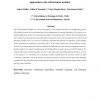Free Online Productivity Tools
i2Speak
i2Symbol
i2OCR
iTex2Img
iWeb2Print
iWeb2Shot
i2Type
iPdf2Split
iPdf2Merge
i2Bopomofo
i2Arabic
i2Style
i2Image
i2PDF
iLatex2Rtf
Sci2ools
111
click to vote
ESWA
2010
2010
A numerical comparison between simulated annealing and evolutionary approaches to the cell formation problem
The Cell Formation Problem is a crucial component of a cell production design in a manufacturing system. This problem consists of a set of product parts to be manufactured in a group of machines. The objective is to build manufacturing clusters by associating part families with machine cells, with the aim of minimizing the inter-cellular movements of parts by grouping efficacy measures. We present two approaches to solve the cell formation problem. First, we present an evolutionary algorithm that improves the efficiency of the standard genetic algorithm by considering cooperation with a local search around some of the solutions it visits. Second, we present an approach based on simulated annealing that uses the same representation scheme of a feasible solution. To evaluate the performance of both algorithms, we used a known set of CFP instances. We compared the results of both algorithms with the results of five other algorithms from the literature. In 8 out of 36 instances we conside...
| Added | 02 Mar 2011 |
| Updated | 02 Mar 2011 |
| Type | Journal |
| Year | 2010 |
| Where | ESWA |
| Authors | Andres Pailla, Athila R. Trindade, Victor Parada, Luiz S. Ochi |
Comments (0)

